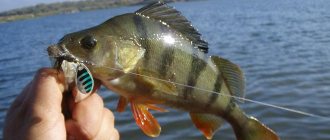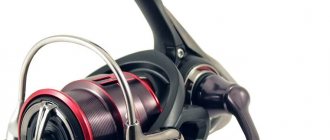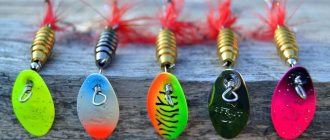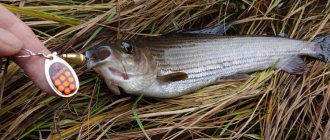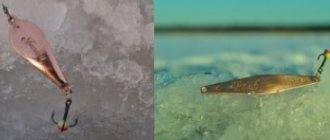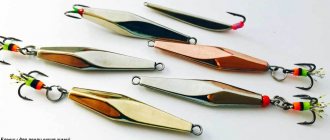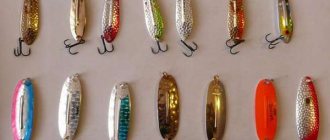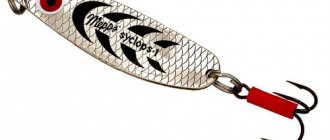What's happened
A rotating spoon is a rod with a tee at the end and a petal loosely placed on the rod, which, rotating around an axis, produces sound waves and color highlights, attracting the attention of fish.
Operating principle
When the spoon moves, the loosely reinforced petal rotates around its axis and creates effects that are attractive to fish:
- color highlights;
- sound waves of different frequencies;
- hydrodynamic wake.
The spoon imitates the movement of fry, caddisfly and other insects.
Expert opinion
Knipovich Nikolai Mikhailovich
Zoologist, hydrobiologist. I am interested in fishing at a professional level.
Attention! In hot weather, a large predator will prefer a small ultralight spinner.
What they look like
Spinners consist of a wire on which the load is attached, a rotating petal, material for the body of the spinner (in the form of beads, cylinders, wire), a hook (usually a tee). To attract the attention of a predator, a tee edge can be added.
Kinds
According to the degree of loading, rotators are divided into:
- front-loaded - the load is located in front of the rotating element (jigging version);
- medium-loaded - the load is located in the middle of the spoon, at the same time being the body of the spoon, the petal rotates around the load;
- rear-loaded – load behind the petal;
- unshipped – spinners without shipment.
An important characteristic is the angle of deflection of the petal when rotating relative to the body of the spinner . Industrial versions of spinners from the best company producing spinners, Meps, are available with angles:
- 30 degrees – “long” ;
- 45 degrees - “comet” ;
- 60 degrees - “aglia” .
Another important characteristic is petal shape :
- round;
- ellipsoidal;
- in the form of an elongated willow leaf.
For high-frequency playing and during currents, a narrow willow leaf is used. The round one rotates more slowly, at a larger angle. Ellipsoidal - average between a willow leaf and a round one.
The more passive the predator, the slower the petal should rotate. For inactive fish, a round or ellipsoidal petal is better.
For an active predator, high-frequency play is attractive. He will be more interested in the willow leaf.
Expert opinion
Knipovich Nikolai Mikhailovich
Zoologist, hydrobiologist. I am interested in fishing at a professional level.
Important! A fisherman's kit should include spinners of all types. It is unknown which spoon is more suitable for a particular body of water.
How to assemble a spinner spoon with your own hands?
When creating all the elements of the bait, it is necessary to pay great attention to the size and shape of the petal - since this is the main part of the spinner. The narrower it is, the smaller the angle at which the spinner will deviate from the axis of symmetry will be, and the faster its rotation will become.
To attract predatory fish like pike, it is better to use oval petals that rotate slowly, and to catch perch, on the contrary, narrow, exciting high-frequency vibrations.
Making spinner spinners with your own hands also involves choosing the shape of the petals, which come in different shapes:
- “Indiana” is a bait with an average range of indicators;
- "Colorado" - a spinner with enormous lifting force;
- "Mepps French" - a universal elongated turntable;
- “willow leaf” is a bait for retrieving in still water and fast currents.
The petal of the pinwheel is cut out with special metal scissors from brass, tin or copper, no more than 0.5 mm thick. After that, a rounded hammer is used to give this part a convexity, bend and shape.
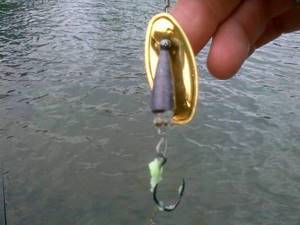
Making at home
Required tools:
- round nose pliers;
- pliers;
- knife;
- awl;
- hammer;
- file;
- needle file;
- metal drills 0.5-2 mm;
- drill;
- Bulgarian;
- scissors;
- metal scissors;
- hacksaw for metal.
Necessary materials for making homemade products:
- can;
- ferrous wire 0.2-0.6 mm;
- tea spoon;
- sheet of iron, copper, cupronickel 0.2-2 mm;
- A strip of iron or copper 1-1.5 mm wide;
- lead block;
- fishing weights;
- beads of different sizes and colors;
- wooden block;
- wool threads;
- tees.
You just need to take three steps and you will have experience in making catchy rotators yourself.
A simple spinner in 10 minutes
The easiest to manufacture is a student's unshipped rotating spoon . Done in 10 minutes. What is necessary:
- Cut a round or ellipsoidal petal from a metal lid for jars, a tin can or a plastic bottle.
- At one end of the petal, punch an awl or nail, or drill a hole 0.5 -1 mm.
- Straighten the paper clip and give it an even shape using a hammer and pliers.
- At one end of the wire from a paper clip, twist 2.5 or 3 turns around a metal rod or nail. You will get a ring for attaching the fishing line. The ring can also be screwed on with pliers.
- Place a small bead on the wire and stretch it to the ring.
- Insert the wire into the hole of the petal, stretch the petal to the bead.
- Put on a couple more beads of the desired colors.
- Wind 2.5 or 3 turns on the other end of the wire under the tee or winding ring.
- Place a hook or tee.
The spinner is ready. If desired, you can add a colored edge to the tee by tying it to the fore-end of the tee with thin wire or securing it to the fore-end of the tee using heat-shrink tubing.
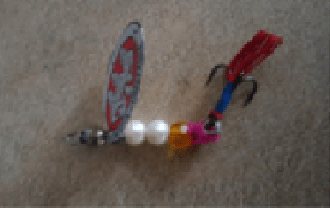
You can cut out two identical petals and glue them together. This will take an extra 3-4 minutes, but the petal will become heavier and the spoon can be cast at high speed.
A student's turntable may not be very strong and durable, but if everything is done correctly, the petal will rotate. Pike or perch will definitely be interested in the product.
This spinner is the first step towards making catchy lures yourself. It does not need to be polished, sharpened, painted, etc. It is designed for slow wiring with slow rotation of the petal.
From a teaspoon
You can make two types of petals from a simple teaspoon:
- narrow like a willow leaf from a spoon handle;
- ellipsoidal concave from the scoop of a spoon.
With front loading with clamp and ellipsoidal petal
- On a ferrous wire 0.2-0.6 mm we make a ring on one side, as already described above.
- Using a grinder or a hacksaw, saw off the handle of a teaspoon at the base.
- We grind off the excess protrusions from the resulting curved ellipsoid with a file, giving the future petal an ideal shape.
- Drill a 2 mm hole at a distance of 3 mm from the edge of the ellipse.
- We make a rotating clamp for the petal from a strip of metal 1-1.5 mm wide.
- Using a metal drill, we drill holes on both sides of a metal or copper strip that are 30% larger in diameter than the diameter of the spinner wire;
- bend the strip into a semicircle.
Expert opinion
Knipovich Nikolai Mikhailovich
Zoologist, hydrobiologist. I am interested in fishing at a professional level.
Attention! The semicircular shape of the clamp can be replaced with a triangular one. Then the petal will rotate at a greater distance from the body of the spoon.
- We put the petal on the collar.
- We thread the wire into the clamp.
- We string the required number of beads of the desired sizes and colors onto the wire.
- We make a back ring for a tee or winding ring.
- We hang the tee directly on the ring or through the winding ring.
- The front load can be placed on the wire before the clamp is put on, but is most often hung directly on the main line or leader.
The front loading of the required weight can be made from a block of lead, hammering it into any desired shape. More often they give a triangular shape in the form of a fish’s head.
Additional actions:
- If necessary, we make the edge of the tee.
- If necessary, paint the petal with nail polish.
The spinner with an ellipsoidal petal with front loading is ready.
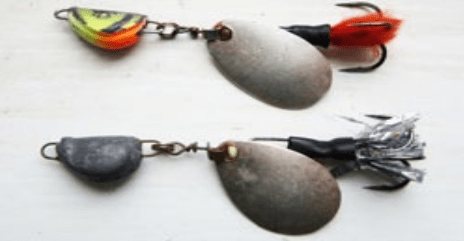
With front loading with yoke and swept blade
Using the same principle, we make another spoon with a narrow petal made from the handle of a spoon.
- We cut off an extra narrow piece from the handle of the spoon with a grinder or a hacksaw.
- We give the workpiece an arrow-shaped shape of a willow leaf with a grinder or a file.
- We make the remaining parts of the spoon in the same way as in the previous section.
- We assemble the turntable in the same sequence as described in the previous section.
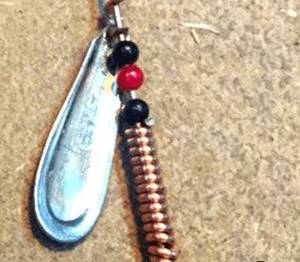
Expert opinion
Knipovich Nikolai Mikhailovich
Zoologist, hydrobiologist. I am interested in fishing at a professional level.
Attention! You can add additional attractiveness to a homemade petal by punching notches or indentations with a hammer and chisel.
With an ellipsoidal or arrow-shaped blade with a median discharge
- We repeat all steps up to point 7 from the section “With front shipment with a clamp and an ellipsoidal petal.”
- We string a clamp with a petal onto the wire.
- We string one or more beads of the desired sizes and colors onto the wire.
- We pour the middle shipment from molten lead in the form of a spindle, cylinder or any other desired shape, drill a through hole, and put it on the wire.
It’s much more interesting and much easier to make a middle shipment in the form of a spinner’s body this way:
- We put ready-made lead fishing weights - balls - on the wire.
- We put heat-shrinkable tubing of the desired color on the balls for electrical wires.
- Let's heat it up. The insulating material will tightly wrap around the balls, giving the body of the spinner a finished shape.
- We make a ring at the end of the wire to attach the tee or winding ring.
- We hang the tee.
Expert opinion
Knipovich Nikolai Mikhailovich
Zoologist, hydrobiologist. I am interested in fishing at a professional level.
Attention! You can put on sinkers sequentially, starting with a small lead ball, then put on sinkers of increasingly larger volumes. Having reached the maximum volume, then put on sinkers of decreasing volume. This results in a segmented spindle-shaped body of the spinner.
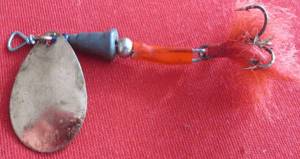
With rear loading
- We put on beads and a petal in the head and middle parts.
- We place the shipment of the desired shape and weight in the back of the spoon closer to the tee.
Petal made of sheet iron, copper, cupronickel
- We prepare a matrix from a block of wood - a recess to give the petal the desired shape.
- We place a sheet of iron 0.2-2 mm thick on a wooden block.
- We beat the petal with a hammer, gradually giving it the shape of a matrix.
- Using metal scissors or a grinder, cut out the petal.
- We file the edges of the petal to give it an ideal shape.
Expert opinion
Knipovich Nikolai Mikhailovich
Zoologist, hydrobiologist. I am interested in fishing at a professional level.
Attention! You can use a teaspoon or tablespoon as a matrix.
Next, we carry out the operations of assembling the spoon with front, middle, or rear loading, as described in the previous sections.
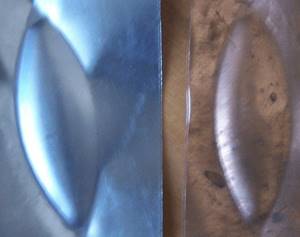
What to look for when using a spinner
When using and purchasing turntables, you should pay attention to the following characteristics:
- Color.
- Size.
- Loading.
- Rotation angle.
- Petal shape.
- Weight.
Color
By its nature, perch is not very picky about the colors of baits, so you can safely use classic colors for it: silver, red, gold and copper tints, bright colors.
As practice shows, perch reacts most to baits that have at least a small particle of red color. This could be a red petal or any other red spots that could catch the fish's eyes.
Size
When choosing the size of a spoon, you should know that the larger it is, the larger the fish it will catch, so the fisherman must first determine what kind of fish he will “hunt” and, based on this, buy a spoon. The classic size of “pinwheels” is considered to be from four to seven centimeters.
Loading
A standard “spinner” consists of a small cone-shaped weight, a ball and an additional weight for casting distance. The cone and ball function to provide free rotation of the petal. The petal itself is attached to a small bow.
The weight does not allow the spoon to dangle much in the water, so it can more smoothly and orderly perform its main task - to attract fish. In addition, spinners can be rear-loaded or front-loaded.
Rotation angle
The angle of rotation can be determined “by eye” by looking at the shape of the petal.
The petal, which has a narrow and oblong shape, has a rotation angle of about thirty degrees, therefore, due to the fact that it has low resistance, it can be used in large currents.
Spoonbaits whose petals are oval in shape usually have a rotation angle of fifty degrees. They are able to attract fish from very long distances, since they create certain sound waves with their structure.
Tools and material for a homemade catching spinner for pike
What do we need for a homemade turntable?
Material:
- a piece of tin (the most affordable and suitable is a lid for screwing on jars - remember the preparations for the winter),
- winding ring,
- beads,
- paper clip,
- tee,
- sinker,
- red cambric.
Tools:
- pliers,
- scissors,
- ruler,
- marker,
- awl,
- sandpaper or file.
Making a homemade catchy rotating spoon for pike
1. First of all, you need to draw up a drawing of the future spinner and transfer it with a marker to the tin lid.
2. Then we carefully cut out our blank. It turns out the basis of the future spinner. By the way, in common people such a spinner is called a pike triangle.
Homemade spinner for a toothy pike - drawing
3. Make holes in the upper corner of the triangle and in the central petal of the tail using an awl.
4. Bend the outer tails at an angle of 45 degrees - like a propeller screw. And we bend the central tops with holes at 90 degrees in one plane.
Now we can start decorating the spoon - we’ll paint it with silver manicure varnish so our spoon will play effectively in the water.
5. Take a paper clip and bend it into a straight wire. We make a loop at the end.
homemade rotating spoon for pike - manufacturing process
6. Thread a sinker and a couple of beads.
7. Then our homemade spoon and again a bead. At the second end of the straightened paper clip we make a loop.
8. We pull the red cambric onto the tee and put on the winding ring.
9. The last step is to connect our entire structure together - hang the hook on the base.
To add brightness and match the look of a real fish, you can paint the side tails, bent at 45 degrees, red – again using nail polish.
With these simple steps, we made a catchy spinner spoon for pike with our own hands.
Wide field for experiments
As mentioned above, the ideal symmetrical shape of the spinner with a beautiful varnish coating of the petal is needed more by the fisherman than by the fish.
Petal
The petal does not have to be given a perfectly symmetrical shape. By experimenting with slightly bending the edges of the petal in an asymmetrical shape, you can achieve uneven and chaotic movement of the spoon. The spinner will be able to start playing, creating different frequency sound waves and leaving an uneven hydraulic trace, characteristic of a sick fish or a chaotically moving insect.
Expert opinion
Knipovich Nikolai Mikhailovich
Zoologist, hydrobiologist. I am interested in fishing at a professional level.
Attention! This game is obtained if the petal is made in the form of a tree leaf with a curved sharp end.
Numerous notches can be made on the petal so that it can produce additional turbulence and different frequency sound vibrations.
Spinner body
You can experiment with the body of the spoon, slightly bending it at different angles.
Instead of beads, you can use an electric wire, winding it onto the wire of the spinner.
Spinner with two rotating petals
- Beads or a solid tube of a certain length are placed behind the first upper petal.
- A second petal of a different length than the first is hung.
The main thing is that the second petal does not touch the hooks of the tee when rotating.
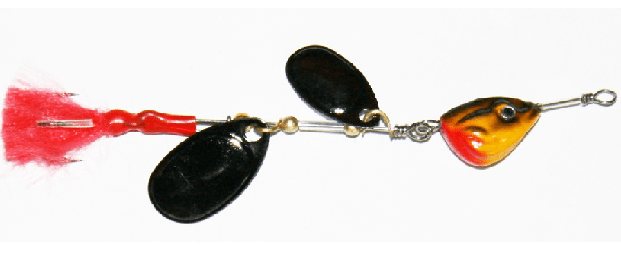
Again a reason for experimentation:
The edge for the hook is best made from red wool threads. This is done as follows:
- Wool threads are inserted into a small piece of the desired color of heat shrink tubing. Its length should be slightly less than the forend of the tee. It looks like a bouquet in a cylindrical vase.
- A tee is inserted into the middle of the bouquet so that the eye extends beyond the tube.
- The thermophilic material is heated, tightly enveloping the forend of the tee and the wool threads.
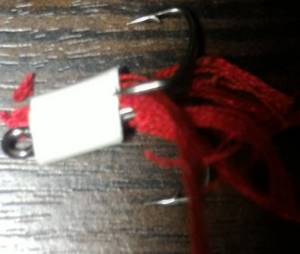
The edge serves to camouflage the hook and to additionally attract the attention of predatory fish.
Expert opinion
Knipovich Nikolai Mikhailovich
Zoologist, hydrobiologist. I am interested in fishing at a professional level.
Interesting. As an alternative attractive element for the spinner, instead of the edge, you can use small silicone baits placed on a tee.
